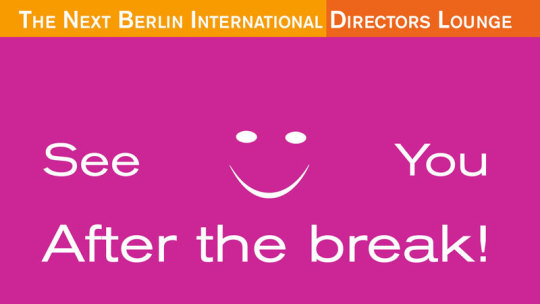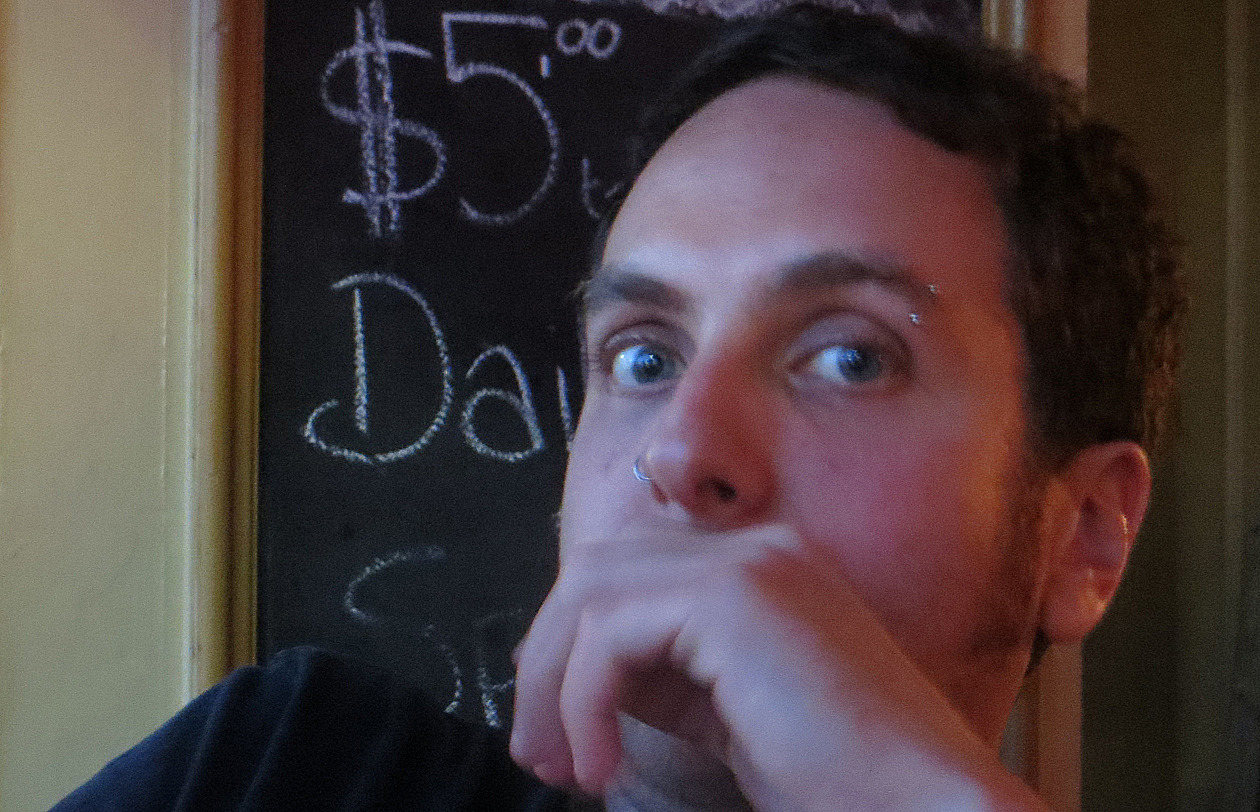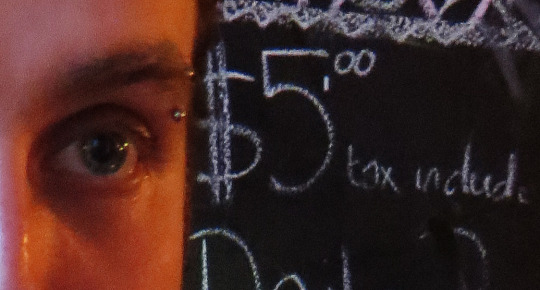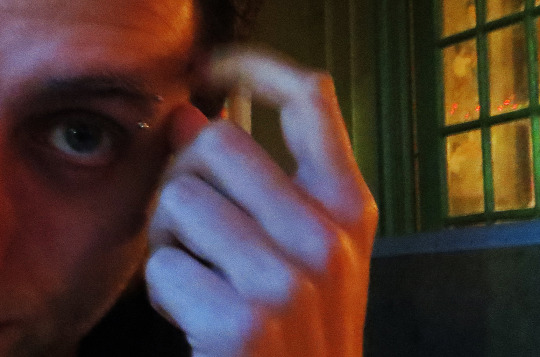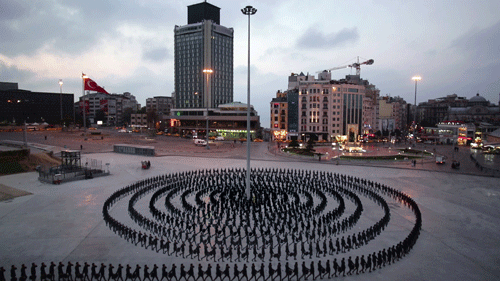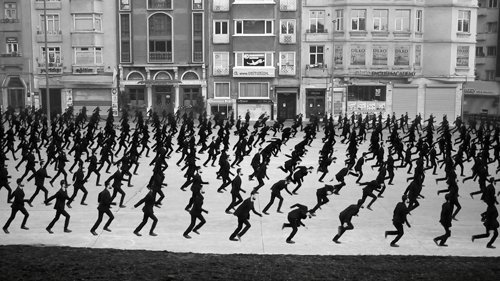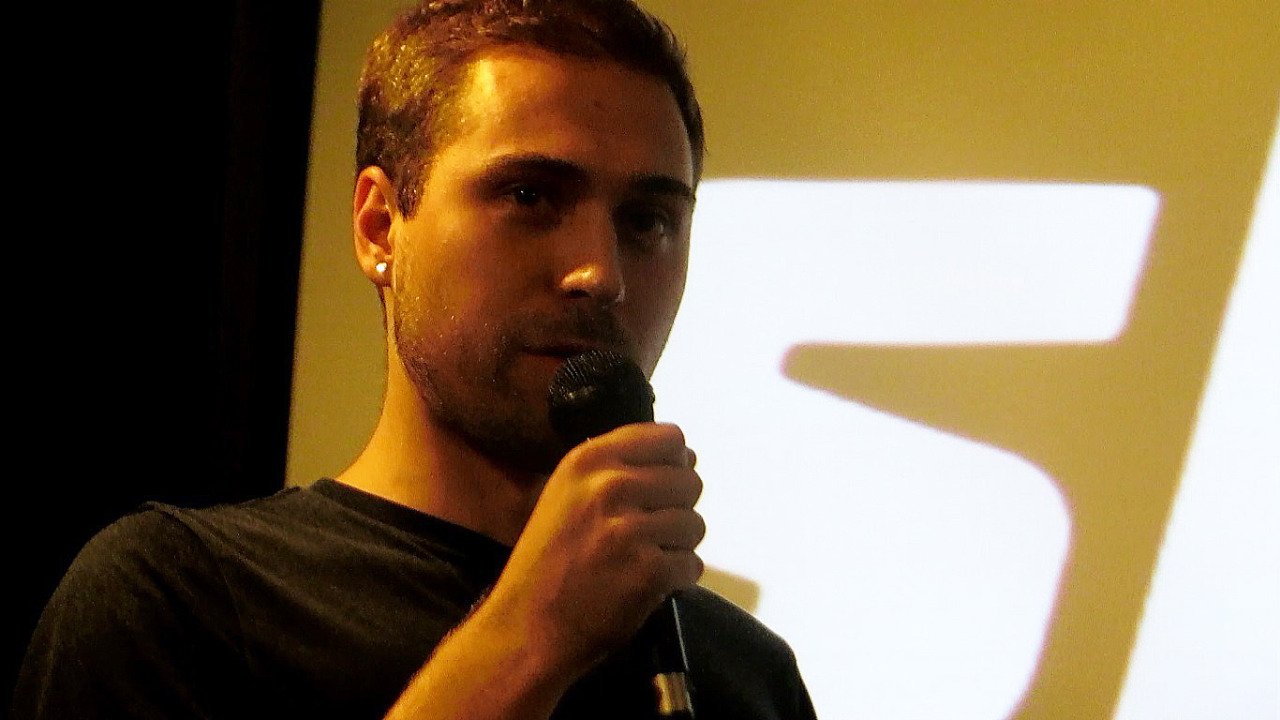
WHY MEN BUY ROSES
Filmmaker-cum-filmfest fixture Alexei Dmitriev gets loose on jury scrapes, artistic binge-drinking, the depths of karaoke… and what’s left to learn from Russians
by Kenton Turk | Directors Lounge Magazine
ALEXEI FROM ST. PETERSBURG comes at us with drinks, five in number, deftly clutched in the fingers of both hands. “Watch out for these, they can be murder,” he says, and when a Russian says it, you know it must be true.
There is no official stamp on this gesture, but somehow I feel as though the annual DL festival has gotten officially underway.
Years back that was, my second encounter with Dmitriev. The first was not as good – a self-formulated introduction to a compact figure curled over the kind of technical equipment I avoid, in smoke-grey light, deep in the night after a flurry of films at DL’s February filmfest. Later he apologizes for his mood of the hour – he apparently had heaps on his mind. Fast forward – by now, I’ve encountered him a good number of times, here in Berlin, over in “Peter,” the naked left shoulder of Mother Russia. I know some of his dislikes – he transmits these often enough free of solicitation. In the number: the hipsters of St. Petersburg’s Novaya Gollandiya Park (or anywhere), “manspreading” on the city’s trains (or I presume anywhere). But negative he is not. He has a number of loves, things he pursues with Russian passion – healthy they may not all be, but relished. Palpably.
Alexei is a singularity in the DL cosmos, a kind of Sputnik 1 that circles it and transmits signals of life out there among the heavenly bodies. He has created specially curated blocks of oddities on a fairly regular basis, the last being “Alexxxei’s Program” at [DLX],¹ a pan-global mix of cleverly sexual cinematic swipes. His onstage demeanour, whether announcing the line-up or answering queries on his own films, carries an overtone of bedside charm – intimate, loose, unvarnished. Example: he invites the audience at a recent Shortcutz special presentation of his films to come see his latest, The Shadow of Your Smile, at the upcoming Porn Film Festival in Berlin with the words, “We’ll watch some porn together,” lowering his eyes and promising them “bonding.” Titillated laughter from the gathering. A sly smirk from the stage. Dmitriev regards the audience like a cat that has just mastered the art of purring. Probably doesn’t suffer too many lonely nights, unless by choice. At the festival, a day or two later, the screening room is full to overload during the block with Shadow. How many came to see the man from St. Petersburg is impossible to say. The word “porn” still bears evidence of being able to attract on its own.
Tonight, Dimitriev is prepared to talk to me in higher-than-usual decibels, a necessity in the bar we’ve made our way into – his idea, a favourite among many near the Kottbusser Brücke. Rauchverbot hasn’t made its way here – the tight crowd smokes until it penetrates your clothes. He knows the bars of Berlin and other cities better than well, and is always open to new discoveries. We have done the rounds a number of times in the past. Crawling through some of these one night with me in consenting tow, he runs into pal after pal from country after country in bar after bar – mostly filmmakers with exotic accents and offbeat tales. Some I know as well. These creatures are like the trail left by Theseus in the Labyrinth, something you leave in your wake to follow up later.
“We basically created the whole idea of subtitles for festivals in Russia. Before that, they were also dubbing the shorts. There is a booth, and a woman with an extremely monotonous voice, and she goes, ’Na-na-na-na-na-na-na.’ It kills everything.”
IT ISN’T EASY to find a seat, but we get a couple near a warm radiator and a cold window. Dmitriev rarely dresses like he is looking to be noticed. Browns and muted blues predominate, as tonight. I prepare to do what I haven’t with him before – talk “on the record.” The idea is to let Alexei take things where he chooses.
We start off in mock earnestness. This feels a bit strange, considering our usual banter and that of moments ago. I address him by his first name (I’ve never learned his patronymic name) to indicate we’re underway. Like a man about to be sentenced, he replies, “Yes?” He is solemn and his eyes don’t flicker. I want him to start by telling me something about himself I don’t know. He has not made a great effort up until now to be candid to those who may be interested. His cryptic one-line official bio reads: “Since I was a little girl, my dream was to star in an experimental film.”
He rarely deliberates. (I must have known it, but only now am I aware of it). Without any delay, he fires, “When I was a kid I wanted to be a archeologist.”
OK. An unrealized dream. That I didn’t know. Why isn’t he one now?
“Well,” he says, getting rolling, betraying a hint of the swells and untertow of his native language, “the problem is all the cool stuff is already discovered. I wanted to be an Egyptologist, and all the Rosetta Stones, all the King Tut’s graves are found, so there is almost nothing else exciting to find. And I don’t want to be in anthropological archeology, where you find bones. I don’t like bones,” he adds in characteristic abbreviated summary, “I like stuff.”
Alexei always has definite ideas about what he does and does not like. His likes he can reel off as though thumbing through a catalogue: “Dancing, karaoke, cats, football, good paintings, good food, cooking, ladies, good coffee… a lot of stuff.” The order is admittedly random. His distaste for “bones” compared to “stuff” could be a touch of misplaced resignation, even fatalism. It can be counterproductive to see things in terms of being finite, especially for artists. It might be possible to say that all the good films have been made as well.
No… and yes. “I think not all the good films, but all the topics have been covered in a way,” he opines, “so you don’t have to go for something that will shock and surprise people, in the sense of science fiction. The presentation, the context and the way you’re doing it could be surprising. As one Russian singer once said, ‘All my songs are about the same topic, love to God.’ As a Jewish friend said, ‘All my films are about suffering.’ So maybe it’s true.”
It should be mentioned up front that in Alexei’s case, “all my films” means a scant number of shorts, not exactly the highest output. No real surprise for someone who spends his time attending as many festivals as he does – some 25 a year, by his estimate, often as jury member… or prize-winner.
Agreement from his side. “I’m one of the few people who cannot have the word ‘prolific’ in their biography,” he admits. “Four films over the last nine years. Altogether, it’s 17 minutes.”
17 minutes, nine years… we’re talking about an average of two minutes per year? Pravda, you can’t call that prolific. On top of that, they are largely constructed out of found footage. At the same time, his films are surprisingly varied. They toss and turn in terms of style like Bowie in the 70s. Maybe it’s down to the long breaks between. Maybe design. Four years separate the first film (Dubus, 2005) and the second (Abstract?, 2009). Something must have derailed him there.
Part of it is in fact by design. The explanation: “I have very strong self-censorship, so as soon as I am happy, I can show it to other people. I don’t do stuff that I don’t feel cannot be improved anymore.” It takes me a moment to sort out the triple negative in that last sentence. Alexei keeps on, his feet clear of the brakes. “And sometimes in my films, a couple of them, I have moments where I know that they could have been better, but it’s impossible with this material, or there was no other material, or it would have been stupid, or too long, so I release the film as soon as it’s ready.” A second admission follows, putting the foregoing in another light. “Thus, I’m also a very lazy person.”
A number of people claim that – strangely, many of the most productive ones. DL-featured digital artist Erdal Inci comes to mind. But more has kept him away from exploring his own inventiveness. Bringing arty films to Russia free of linguistic slaughter turns out to be the other reason for his relative lack of productivity with his own creations. “Basically,” he drawls, eyes adrift, “a year and a half after the first one, a friend of mine and I founded a company to show, promote and make festivals and short films. We basically created the whole idea of subtitles for festivals in Russia. Before that, except for arthouse cinema, they were also dubbing the shorts. There is a booth, and a woman with an extremely monotonous voice, and she goes, ’Na-na-na-na-na-na-na.’ It kills everything. Imagine seeing a 30-minute French fiction short where three women are talking at the same time. You don’t get anything!”
Not true. You get something: an unexpected multi-media experience. I have experienced similar in Prague – The Trial, Orson Welles, English with French subtitles and an elderly woman speaking all the parts in Czech. With occasional coughing attacks and the resltant picture-dialogue dissonance. Kafka-worthy confusion, live. Dmitriev and his co-crusader saved Russian cineastes from all that. No easy ride. “Apart from subtitles,” he expands, “we were also translating, doing screenings in 35 cities in Russia. We would make a program or bring a festival from abroad and show it around the cinemas, because with short films at that time, there was no scene for it, except for a couple of festivals in Russia. We were bringing features that would never have had distribution in the country. We were doing a music video festival, national film weeks. We were also working with people who wanted to do a festival but had no idea how it’s done – how to promote it, how to publicize it, how to get the copies. So we were doing everything.”
Too much, it turns out, at least where filmmaking is concerned. Even if there was another dividend. “After four years I understood that I don’t even have time to show my second film in person. I was loaded with money, but I had no time. I couldn’t attend any screenings. My films are very short, but I didn’t have time for three minutes in four years. I decided, OK, something’s got to change; otherwise, I’ll stay a festival person. I could be the director of some big festival in five years, or curate or advise or whatever.” The decision: “I decided to come back to film.”
With this talk of film and Russia, it’s tempting to imagine Dmitriev as a latter-day Doctor Zhivago, braving the elements, bringing arty films to the needy in Novosibirsk, Kamchatka, Vladivostok. Or passing days on the Trans-Siberian, watching the Steppes fly by, his suitcases loaded with offbeat flicks. Inaccurate, but a good film motif.
Still, the trekking does cover enormous distances and take in inhospitable regions. Alexei elaborates: “We took all the 17, 18 cities over one million, and then smaller ones, but the most important ones, for example Surgut, one of the oil capitals in the middle of Russia, but north, really far north, toward the Arctic. A lot of the cities, they might have a cinema, but they only get one, only blockbusters or bad Russian films. You’re in a city of, let’s say, half a million, and they’ve never seen a short film, except for some advertising or some funny animation on YouTube. I guess the closest festival is maybe 5000 km from them. I think we did 15 or 16 in person over the years. It was hard because a lot of the cinemas were state-owned. To make them understand what we were doing, that it is profitable in the end, and that it also attracts a young, new audience… it took a while.”
A Russian proverb: Byeshyenoy sobake sem’ vyorst nye kryuk. Translation: “For a mad dog, seven miles is not a long detour.” What does that make the madness potential in this particular dog? More from proverbs: Every man wants to leave his mark. This may be his, successful beyond the reach of his hand. Alexei: “The company is still running. They have a chain of 35-something cities in Russia, though they’ve decreased the amount of things that they do. It’s become less edgy, less experimental, but still, for short films, that’s one of the two or three biggest companies in Russia.”
“Karaoke was, in the beginning, a drunk trial. I [did] ‘The Girl from Ipanema’ – blind drunk, the Portuguese version. Not very good, but I got a round of applause, and my dad cried.”
THE CONFIDENCE TO GO ON STAGE and present films came by way of one of his declared loves (liberally spiked with spirits): karaoke. His attachment to this bit of social kitsch is well-known in the Euro-filmfest scene; it was in fact one of the first things I ever heard about him. The seeds are laid long ago – back in the USSR, as the song goes.
“First of all, my dad used to be in a children’s choir in the USSR,” he begins. “He’s from a very small town, like 10,000 people. When he was between ten or eleven, they won the USSR children’s choir competition, and they sang in the Kremlin. My dad actually sings really well. When he wakes up, he starts going around the house singing complete bullshit, made-up songs. Even in a house with these particular acoustics, it’s… very good. And both my brothers are musicians, so the male part of the family is really musically gifted. I’m the only one who cannot play anything and who is a shit singer. I always envied musicians, because of this direct interaction with the audience. So karaoke was, in the beginning, a drunk trial.”
While tempted to look at Alexei in terms of being Russian (maybe a compliment, given my taste for Dostoyevsky, Rachmaninoff, Chekhov), he is more that breed of man-about-globe for whom flying is not much different than strolling, and borders are hazy lines. Rarely at home and seemingly at home everywhere. It follows that the story picks up thousands of kilometres away, on the Iberian Peninsula. Like most of his tales, soaked in alcohol. “I was bar-hopping in Lisbon, like 20, 30 bars. We ended up in a karaoke place, a proper one with tables, people sitting, big stage. You’re alone, and the stage is ten metres long, so it was really like performing. And in Portugal, everyone knows how to sing and dance. In the end – I’m a big fan of Astrud Gilberto – I said to the guy, ‘Hey, can I do ‘The Girl from Ipanema?’ He said, ‘Yeah, that’s going to be the last song.’ I went on stage, blind drunk. They only had the Portuguese version – and I don’t speak Portuguese. But I know the Portuguese version. So I did it. It was not very good, but I got a round of applause and my dad cried, so I said, ‘OK, that actually was quite rewarding.’”
Not the end of the story. On one of my trips to Russia, I get to see Alexei in action. Hours after having my ID, transport, debit and credit cards stolen in the Petersburg Myetro (a rite of passage in Russia; the latter surfaced shortly after as attempted payment for thousands in jewellery and other items), I hit a local karaoke with him to let my frustration out as Jagger, Morrison, anyone who can let out a good scream. (Must have been OK; sweating Russians slapped me on the back with the heavy-duty accolade, “Kruto!”) Alexei rarely let his handprint cool down on the mike, belting out number after number to a rough and ready crowd of serious drinkers. But in a simbiotic exchange, one stage experience bolsters the other. Alexei: “I’ve been on stage in the sense of presenting films, my films or other people’s films, since I was 21. That already taught me a lot – how not to be shy, how to deal with the audience, where to look, la-la-la…. But karaoke is a bit different, because you’re actually not talking, you’re singing. You have to make it either good singing or that people want to watch you.” The din encroaches, Alexei pushes it back. “I like it. I’m not that good, but that’s my thing.”
“Festivals have to stop caring about films being offline or on. My films were seen by 10,000 people, offline by 20,000. The difference is huge.”
CONCEIVING AND EXECUTING a restless and ground-breaking film road show, one of his other “things,” has lent him the creds and clout to make him a near-obligatory figure on the Euro-filmfest circuit. He knows everyone (in film), has seen everything (on the screen). At least, you could get that impression. Photos show evidence of a good amount of extra-curricular merry-making on the jury circuit, but he takes the assignment seriously. As he does the merry-making, please note. The work-hard-play-hard-drink-hard type.
Selecting what to down for the next round in a bar is however easier than selecting films to honour. The democratic process has its drawbacks. Exhibit A from the vaults: difficulties selecting a prize winner from a lot spanning the good, the bad and the ugly. City and names intentionally withheld. “Film number one was shit,” Dmitriev says with typical directness, but not before pointing out that the theme from “Dr. Who” is playing in the background. “The other films were either good or discussable. Then we went into discussion.” Decisions are easier with the dross quickly filtered out.
Next: a Mexican standoff. One jury member opts for the “shit” film. No reason given. No flexibility. The cowboys freeze, guns drawn. Not that Dmitriev balks at disagreement – he seems to like it on occasion, better with an attention-starved shot glass in hand. But he wants a rationale when it comes to film evaluation. The dissenter won’t be budged past a foggy single-sentence assessment. Dmitriev is irked. “He said, ‘It obviously was the best.’ No argumentation, no reasoning. The crappiest film, that was his cup of tea.” This brand of nebulous justification clearly irritates him. “When you’re on the jury, you have to prove why this is better than that….”
Twelve Angry Men with a micro-cast, in colour and 3D. But there is more to deal with out there. Alexei readily weighs in on what needs to die in the film festival world, with vexation on speed-dial. Pet peeves parade forth, one malcontented matrioschka after another.
“First of all, nepotism,” he begins. “Being selected because you’re friends, because they’ve shown all of your films. Also, film schools really have to change. Film production and distribution has to change. Festivals have to stop caring about films being offline or on. My films were seen by 10,000 people, offline by, let’s say, 20,000. The difference is huge. Filmmakers have to stop producing too much material, be more accurate at what they’re doing. Also, how to deal with online distribution, how to deal with offline distribution.”
This is a recurring theme in Alexei’s rundown: the rotting fruits of technological advance. Paradoxically, also resistance to change. “The world is changing rapidly,” he continues, “and the film industry doesn’t change that fast. There should also be more young people. A lot of really big festivals, really big companies are controlled by people in their 60s, and they are doing stuff for the people their age.”
He agrees that the other end bears its own problems: after two feature films, you’re no longer fresh meat, and unlikely to be served up as a featured dish at certain festivals. Bigger still: who profits from the trailblazers. There is still dangerous terrain between innovation-smiths and those who stuff their pouches with golden talers. Dmitriev feels a need to guard the avant-garde – art and business don’t always marry off well. “Coming from experimental film, also a music video background… big guys immediately start using things you did. You can do a great piece of video with an interesting visual approach or effect, and it will be immediately stolen by commercials. It happens all the time. Same with experimental film. A lot of stuff that people did over the years, like Jonas Mekas or Stan Brakhage, got so commercialized that it doesn’t feel like theirs anymore. And obviously these guys never got paid. Somebody saw it and said, ‘Hey, we can do this shit, but make it profitable.’ Corporate laws have to change drastically.”
The crowd around us remains boisterous and loud, happily consuming their poisons of choice and shouting clumps of geniality at one another. There will be money in the coffers tonight, no doubt about it. The commercial end of pleasure has its permanent place, like it or not. Besides the exploitive aspects, there are at least occasional dividends from the “biz” side of film art… and not just a few, in Dmitriev’s view. A number of recent cinema-packers get his nod.
He starts the list. “Commercially this year… Snow Piercer, a Korean movie with older American actors. Very good, post-apocolyptic. I really enjoyed The Guardians of the Galaxy.”
I have to admit giving that one a miss. Alexei is happy to give a spontaneous abstract.
“It’s a crazy, bad superhero movie,” he starts in. “One of the superheroes is a talking raccoon, voiced by Bradley Cooper. It’s insanely funny, it’s very stupid, and it really plays with the superheroes that Marvel and DC comics created over the years, some of them completely bizarre and silly. Extremely good. Lars van Triers’ Nymphomaniac also was released commercially, that was a good film. Leviathan by Andrey Zvyagintsev, an amazing piece of work, but more arthouse. But commercially… I do enjoy watching bad American films, in the sense of superheroes or fantasy. For me it’s OK. It kind of switches off this kind of artsy fartsy thing. You can just watch….”
No doubt his endless festival traipsing and steady diet of artful tidbits to evaluate overloads his capacity for cinematic edginess and subtle subtext to a degree that most don’t experience.
“I’m very open to the normal features, if they’re good, they’re good. I’m really looking forward to the next Mad Max. I saw the trailer, it looks good. This year I was drinking in London, and I woke up with a friend with a hangover. We decided to watch Kung Fu Panda. Amazing! Funny, great, really light, a lot of jokes, greatly animated. You know, I enjoy this as well.”
“I don’t say everyone should study filmmaking. I didn’t, a lot of my favourite filmmakers never did as well. But they should have some experience in a sense as a viewer, what the format is.”
BEING OPEN TO CERTAIN blockbuster crowd-pleasers designed to line producers’ and investors’ pockets does not mean Dmitriev is any less discerning about film method and art – or any less willing to share his angle. Rare is it, if ever, that Alexei is short of a point-of-view he can slam on the table like the winning hand in a late-night game of five-card stud. Jury duty around the globe has brought him an outlet: films to thumb-up or thumb-down. On the issue of what people do in festival films that they shouldn’t do, he rolls out the litany. By category, like a checklist for targeted evaluation.
“Documentaries,” he says, diving in, “the problems are: a lot of talking heads, this American TV thing… you get the information but you just can read it as well; it shouldn’t be a film, to be honest. And with experimental, the biggest problems are that people have done something wrong, forgotten to focus or to develop the film properly and say, ‘Oh yeah, that’s absolute cinema.’ And that really kills the whole idea.”
He has expressed this before, railed against “kind of experimental stuff, but not really experimental films – crappy video art, mini DV cameras, people eating bananas on film, thinking it’s art.” He sums this up the broader problem this way: “Too many people making too many films.”
Unfortunately without a great deal of forethought, to hear him tell it. And the technology that has helped many to even consider shooting a film in the first place is, he says, the culprit.
“That’s become a bit of a problem over the last 5 or 6 years, the whole digital madness.” He picks up a ubiquitous consumer electronic device resting on the table, dangerously near spilt substances. “With this phone,” he says, turning it slowly in his hand, “you can take film, and the quality wouldn’t be that bad. If you play with it, it can be quite decent. So the amount of films people are doing is crazy.”
Could sound like the words of someone waving a tattered flag for a formally schooled approach to filmmaking. Not the case. “I don’t say everyone should study filmmaking. I didn’t, and a lot of my favourite filmmakers never did as well. But they should have some experience in a sense as a viewer, what the format it, because it’s much harder to tell a story in 15 minutes than in 70 minutes. In 70 minutes, you can do a lot of things. In 15, it’s very hard. So there is a lot of this. There’s a lot of not understanding, especially in fiction, how the story works, how the narrative works, what’s important. Animation, for example, is much harder to do. You really have to research the technology and spend a lot of time. Even with 3D, you’ve got plenty to do to make it actually work. But fiction – you take a couple of friends, go into a flat and film something, a love story. It can be total crap, and usually, it is.”
Dmitriev maintains the gunslinger’s penchant for straight-shooting. But note: he likes bullets fired in his direction as well. Example: one night in the wee hours in Berlin, we (he and I plus filmmaker Simon Ellis) are talking on the sidewalk in front of an all-hours bar. The young, transplanted Irish proprietress comes out and issues an edict: “Either come in or fuck off!” Alexei stops short and beams at her through glazed eyes. “I think I’m in love,” he moons.
“I bumped into a video of two guys having sex with a girl. She was laughing her ass off. The guys, you could see in their faces… is she laughing at them? I thought, very interesting… to try to make it more playful. It looks romantic and nostalgic, and then….”
AS FAR AS SIMPLE LOVE STORIES, Alexei hasn’t made one yet. To hear him sum up his four short films to date: “The first one, Dubus, [2005, ed. note] I’d say: music video, jazz, audience-friendly and found footage. The second one, Abstract?, four years later: Rothko,² Hopper,³ paintings, twist and again found footage. Third one, Hermeneutics, two years ago: war, fireworks, again twist, found footage and Second World War. And the new one running now, The Shadow of Your Smile: porn, nostalgia, VHS, found footage and laughter. Something like this.”
What an academic approach to Dmitriev’s approach would look like is difficult to picture. He himself reveals his main tools to be his “right hand, electricity and the Internet,” slippery country when taken in context of The Shadow of Your Smile. On first viewing, the short impresses primarily in being unlike his other films. It quickly takes on a quality – the manipulation, taking something and putting it in a very nostalgic, sentimental sphere, the video noise from the fast forwarding conveniently covering up the naughty parts, the cold shower at the end – all of this makes it very funny indeed. This develops the wry humour present in all four of his shorts to date, and reflects Alexei’s dry-as-wood wit in conversation. Its conception was painless.
“It was very easy.” He takes a sip, swallows. “I was watching porn for recreational purposes, and I bumped into a video of two guys having sex with a girl. And she was really enjoying the process, she was laughing her ass off. And the guys… you could see in their faces… is she laughing at them? Or because she likes it? Or maybe some other reason? Maybe she’s ticklish? And she obviously was having a really, really good time. I thought, that’s very interesting, to find a bit of something….” He hunts down the words. “Because this was very….”
Here he hits his fist into his palm to give an unverbalized idea of the explicit nature of the film before picking up the story. “…To find something a bit more tasteful where a woman smiles and looks at the camera at some point and try to make it more playful. So I was looking for a bit from the 80s or 90s, when VHS was invented, and was used in porn a lot. For me, those were the first porn films I would see. Then to play with it. Also with some VHS noise, and to have a twist, so that in the beginning you’re not really sure what’s going on. It looks romantic and nostalgic, and then… because the title doesn’t say anything, you have no idea what is going on, unless you’re in a special erotic program. So the audience goes, ‘OK, that looks rather sensitive.’ Then when the guy turns and you see what’s actually going on, a lot of people go, ‘Oh wow!’ and they laugh, and then the original music starts and the credits go.”
Not a blockbuster, but a hit with audiences, whose reaction is not lost on the Petersburger. “It’s actually quite nice to see people really laughing, because a lot of my films, that first one… people still don’t laugh during it. They can dance to it, they start clapping, they give me a standing ovation at the end sometimes, but they never laugh. But this one, I’m surprised where it goes with the audience. I still haven’t had a screening where people were silent or wouldn’t clap afterwards, or ask questions. This, surprisingly, became a real crowd-pleaser. The audience really enjoys it.”
WHAT ALEXEI HIMSELF ENJOYS is clearly the short film… while not seeing it as a distinct form in itself. This bit of de-categorization doesn’t make it less, but in fact more, freeing it from its museum-piece status. At the same time, it can make the viewer re-evaluate “feature films” as being often little more than short episodes stretched out like messy roadkill on a superhighway. “Short film is the same thing as a feature film, it’s just short. It’s not a different genre, it’s just a different way, a much more compressed way of telling a story. There are a lot of attempts by Hollywood to squeeze more out. A friend experienced it, after winning a major prize. Folks came over and said, ‘Would you like to make it as a feature?’ He said, ‘No! This story does not expand over 20 minutes.’” Alexei is a staunch supporter of keeping what should be short short.
Compact length acts magnetically. No surprise, he claims. “I mostly watch shorts. Probably, you know, YouTube generation, shorter attention span. I was asked by Dazed & Confused magazine to name my three favourite films. Two of them were short films; one was Man with a Movie Camera. For me, good short films are films by Jean-Gabriel Périot, Nicholas Provost, Simon Ellis. They are as good as most of the features that I see. Aesthetically, a short can be an over two-hour film which cost 150 million dollars, or a really good feature can be a very average or very expensive or very fancy kind of short. So it doesn’t matter; if it’s a good film, it’s a good film, that’s it. There are no other rules about it. It doesn’t matter who acts in it, who directed the film. I don’t care, you know?”
The fluidity of forms, “short” and “feature,” could mean Dmitriev, free of genre specificity, is ready to try his hand at the almighty cinema standard, the feature film. He has been around enough to ensure ideas are not likely in short supply.
“To be honest, I don’t have an idea for one, but as soon as I do….” Here he considers. “I kind of have an idea. It’s very different from what I usually do. It will be basically people telling stories, and then the visuals will be diverse. It can be 40 minutes, it can be 75, I doesn’t matter. Medium blanks from 30 to 60 that nobody wants, except for TV. Festivals don’t. As soon as I get an idea, and I’m ready to do it, absolutely, but in general… I won’t say I’m a short filmmaker. I’m a filmmaker, and that’s it. If I can do something good in 60, good; if I can do something good at eight minutes, great.”
It is hard to imagine what shape a Dmitriev feature would take, given the shorts to his credit. A possible problem, as cited in a talk with Brandon Cronenberg not long ago – the nature of the beast is that, because of the kind of money that has to go into funding anything on that level, some marketability has to be there.
Dmitriev doesn’t react for a moment. Then: “To be honest, I don’t think so.”
Maybe he is thinking about low-budget marvels, thousands, not millions, like the 1988 British thriller Following, made for $6,000 with extensive use of handy talent. Would he going for that approach?
“I would. I work alone, usually, except for the music parts, so I’m absolutely OK doing this either way – myself, or with really good friends who can help out in different stages. Two friends, really good producers, could get some money for this, but maybe 100,000 tops.”
I assume we are not talking roubles. Money is, of course, an issue, at least on an ethical level.
“If it’s a festival success, everyone gets paid properly. If it’s not….” Alexei sorts out opposing concepts of the gravy train. “Festival success doesn’t mean money. Festival success, that would mean worldwide, Canal Plus, or screening over half a year, if you go into theatre distribution. Even if you don’t get a lot of money, but the film just strikes out on festivals, so earning nothing, that’s a good step for a lot of people.”
The festival circuit is a very cloistered group of people, one could think. Like doing paintings and exhibiting them in your back yard.
Agreement, and disagreement. “Yeah, but at the same time, if you’re talking about a proper festival….”
I have to laugh; I am pretty sure I know who he thinks is not on that list.
“The room is 20-25% filled by industry people,” he elaborates. “Directors, producers, festivals, whatever. 75% are actual audience. My first film was shown at 300 festivals, meaning probably around 600 or 700 screenings just in competition, and another 300 without competition. That’s 1,000 screenings, from small cinemas to 1200-people cinemas. So over the years, a lot of people have seen it, and I’m very happy. People have been giving me good reviews. People have been writing fucking PhDs about my films….”
This has to be worth at last half a Palme d’Or. What it is like to see others view you with academic distance, search the landscape of your output for underlying themes and symbolic intent and then proffer it in formalized language… this is an experience not every artist will get to notch on his or her belt. Alexei eyes register double slam tilt.
“I still haven’t got a copy. I learned yesterday the girl who wrote her PhD about me, and Jean-Gabriel Périot, just made a film, a found footage porn film. I was just like, ‘Really?’ It’s a rather small world in the sense of people working and being around it.”
A small and friendly world. If offered ten million dollars to do a feature, Dmitriev knows how he would use the windfall. “To be honest, I would give this money to somebody else’s project. I know a bunch of brilliant colleagues need millions to make their feature. Otherwise I would say no; I don’t need so much money.”
It may be a moment of synchronicity, but Alexei appears unaware of it – while he is saying this, I detect “From Russia With Love” playing over the loudspeakers.
“In the 20s or 30s I would say, yeah – you can learn cinema from us. Now, no. Not anymore.”
THE QUICK AND DIRECT APPROACH, the value of PhDs notwithstanding, might be the best way of prying Dmitriev’s skull open long enough to see how the gears grind. Intuitive, rather than intellectual. He is invariably quick off the mark, up for any game, so it shouldn’t be a problem. We’ve been chucking words back and forth and decide to change the game to call-and-response syllabics – I pitch. Using what’s at hand, I start with what is occupying the glasses on the table between us. “Beer.”
No deliberation. “Me.” Did I hear him right? “Me,” he reaffirms. We go on.
“Fire.” – “House.” I stop him again. “’House’..?”
“’House’… on fire.” Ah. I begin to get how his mind plays with things.
“Berlin.” – “Wall.”
“Russia.” – “Vodka.”
“Film festival.” – “Fun.”
“Woman.” – “Sexy time.”
“Black.” – “Is the new orange.”
“Productivity.” – “Low.” Shades of sitting in a confessional booth.
“Friendship.” – “Forever.”
“Travel.” – “A lot.”
“Character.” – “Chicken.” I don’t bother asking what that is about.
“Hat.” – “Yes.”
That one makes me laugh. He is wearing one. More: “Sound.” – “Stereo.”
“Technology.” – “Depends.”
“Hair.” – “Fresh.” I don’t ask for names.
“Short film.” – “Is the best.”
“Interviews.” – “Fun.”
Wrong answer there. It should have been “torture.” But Alexei seems happy enough. Tonight and in general. This is the kind of place I’ve seen him shake off any fleeting tension in on other occasions. The bar has become a very cozy corner of the world by now – dark, candle-lit, but still loud. An Austrian director friend is out scouting much-needed food and has promised to join us later. Alexei seems content with just his drink. After the rapid-fire verbal Rorschach test, we sit back a moment and do nothing more than take an occasional sip on what’s left in our respective glasses.
Now a Russian compatriot finds us at our table. He is also a creative mind, exiled by choice, at least for the time being, in culture vortex Berlin. A good chance to get another round of drinks. Alexei also gets a chance to cart out his limited German, bar-speak. The common language at our table shifts here and there – English between Alexei and me, German between his friend and me, Russian between Alexei and his fellow countryman. I suggest they allow themselves the opportunity to govorit’ po-russki – I should understand enough anyway. A good chance for a mini-refresher course, despite the noise.
His friend only stays for one round. I have not picked up any new words; above the crowd, I barely heard half of them. Still, it makes me think. What could a West European learn from a Russian? More than linguistic scraps, certainly.
“Obviously, you can’t learn how to dance,” Alexei begins. “Usually people already know how. You can learn how to drink. You can learn – depending on the country you’re from – how to be hospitable but not look hospitable.”
An enviable talent, although arguably the reverse would serve better.
More comes. “You can actually learn how to fight. You obviously cannot learn any good pick-up lines, that’s impossible.” Here, he seems mildly dizzy with the rush of ideas coming at him. “Wow. Unless you’re Dutch, you can learn how to make 700 meals from a potato.”
I thought the Irish did that. I’ve learned something.
“The Irish and the Dutch. Apart from this, it’s hard to say anything, to be honest. In the 20s or 30s I would say, yeah – you can learn cinema from us. Now, no. Not anymore.”
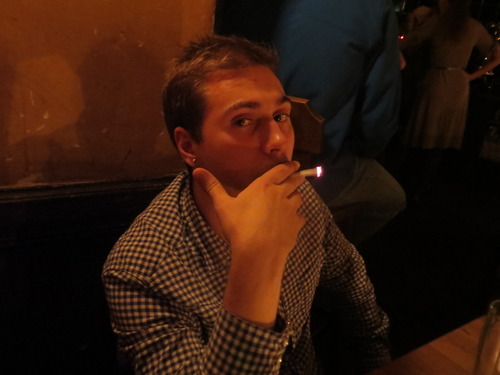
Alexei photographed in Berlin (photo: Nick Font/DL)
STILL, THERE IS THE DRINKING. Finns and Russians are the undisputed masters, searching for days or even weeks for the bottom of the glass. The multi-day drinking binges might fricassee brain cells, might on the other hand bring them to a useful boil. J.G. Ballard claimed the creative “microclimate” in his head came courtesy of a large helping of scotch. Hemingway, Capote, Kerouac did well under the influence. Orson Welles hit the bottle early in life, created his best works early in life. There is a great history of intoxicated ingenuity – Van Gogh, Dylan Thomas, the appropriately named Amy Winehouse. The problem might be remembering anything at all.
“I’m still young, I still do remember,” Dmitriev avers, glass in hand. “Blackouts are not that often. I’ve had a couple of ideas. I write them down during days of partying or being drunk or… They can become a rather nice visual effect in a film, or a good story plot, or something else, a good title. During these days, I came up with some things I might use in the future. Even this can be used creatively. You have to fight the laziness of writing it down. If you are drunk, on drugs or you’re partying, and you have an idea, just write it down immediately. It can be a really good idea. I came up with some really good titles while being intoxicated.”
Lizards make for the toilets. We the warm-blooded stay put. Our wandering Austrian arrives and we prepare to make a move. There are other people to connect with as well in Berlin, and time is limited – in general for many, as a specific rule for Alexei. After Berlin comes Riga, other festivals, no break in sight. Even if his free time is in short supply, the ideas are not likely to dry up or get sideswiped, whether as a filmmaker or entrepreneur of film art. His modest output in the former category have not hurt him a bit. Seventeen minutes of film and he has enough profile to be one of the most regular denizens of the film festival circuit… he might do well to ask the Russian authorities to list it as his profession. He doesn’t bring it up, but the films, beyond being shown from Asia to America, Tribeca to Tempere, have racked up a sizeable number of awards, enough that he has been known to forget this or that one in a station or lounge before hopping a train or a plane to the next festival. Forgetfulness does make an occasional guest appearance.
We are thinking where to go next. Alexei pumps in suggestions. More ideas. You won’t find him short on these or imagination, something he clearly views as a cardinal sin. Or at least a punishable offense. This goes for films, philosophy or flowers. The attitude makes itself known not least in his abundant asides, comments that take in corners of the world and assess them at high speed, leaving behind bits of modern folk wisdom that reveal his spin on what surrounds him. Spying a bouquet, he feels compelled to comment, his eyes dealing their usual death-ray devastation. “Roses are what men without imagination buy women,” he shoots out, another direct hit leaving no survivors. And a bit of personal philosophy that speaks volumes.
¹[DLX], The 10th Berlin International Directors Lounge, Feb. 6 – 16, 2014
²Mark Rothko, Light, Earth and Blue (1954)
³Edward Hopper, New York Office (1962)
pictured: Alexei photographed in Berlin (photos: Nick Font/DL)

![[DL] DIRECTORS LOUNGE DEEP FEATURE NOT FOR THE MIDDLE OF THE ROOM with Brazilian offbeat filmmaker Gabraz Sanna](https://directorslounge.net/wp-content/uploads/2025/06/Gabraz_Sanna_01.jpg)

